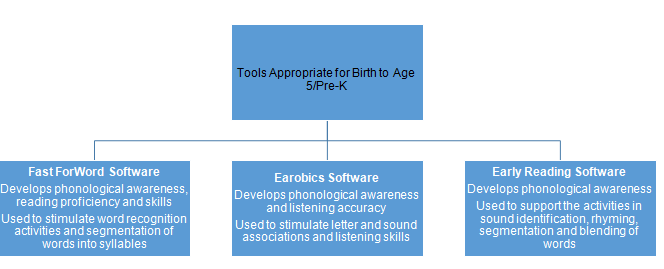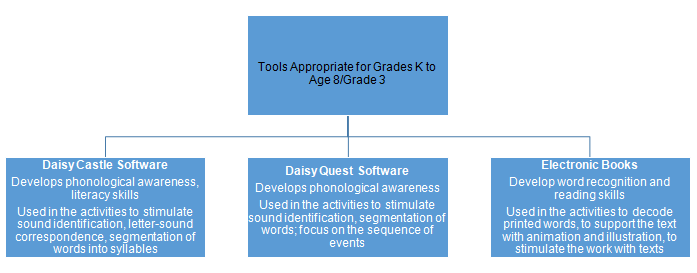Computer technologies are actively used today in the classroom environments to accompany the teacher instructions and to stimulate the students’ attention, memory, and cognition.
To enhance the students’ learning activities and development of their literacy skills, it is possible to use such computer technologies as the computer software and electronic books (e-books) at all the stages of learning because different technological tools are designed to address the needs of all the learners without references to their age and level of the skills’ development.


From this point, to use the computer technologies effectively, the teacher should pay much attention to selecting the appropriate tool which can contribute to the instruction about the students’ performance level and needs. Thus, to add to the students’ achievements, it is necessary to focus on the aspects of the technological tools used for the children aged 0 months – 5 years and for the students aged 5–8 years.
When children only start their literacy education and learn the literacy skills at the Pre-Kindergarten stage, the most appropriate tool to be used is the computer software which stimulates the development of the child’s phonological awareness.
Thus, in their research, Zucker, Moody, and McKenna mention such appropriate software as Fast ForWord and Earobics which can be used to contribute to the children’s phonological awareness (Zucker, Moody, & McKenna, 2009, p. 50). The teacher can improve the usual instructions while involving the children in the interactive activities proposed by these tools.
To stimulate the children’s work with words, Fast ForWord and Earobics provide the interactive exercises with the alphabet and vocabulary. Children receive the opportunity not only to read words but also listen to them and repeat. Early Reading is the software which is designed to respond to the students’ needs in identifying sounds, letters, and words.
Children receive the opportunity to segment and blend the sounds while working with different words (Macaruso & Walker, 2008, p. 270). The discussed technological tools are effective to contribute to the teacher instruction because they are used to demonstrate the opportunities of the interactive exercises (Vernadakis et al., 2005, p. 102).
As a result, children can work with sounds and words while satisfying their needs in learning. While using these tools, the teacher realizes the individual approach to the student because of selecting the exercises and resources which are most beneficial for the child to develop his or her phonological awareness and reading skills.
During the Kindergarten-Grade 3 stage, students need more developed exercises to improve their literacy skills. To enhance the students’ development and to improve the instruction, such resources as the Daisy Quest software and Daisy Castle software can be used.
According to Macaruso and Walker, these technological tools provide the teacher with the great opportunity to combine the elements of the video, audio, and texts to propose the specific interactive exercises (Macaruso & Walker, 2008, p. 268). The above-mentioned programs are effective for the Kindergarten stage because students continue to develop their phonological awareness and reading skills.
Following the content of these programs, students can train in rhyming, segmenting and blending syllables and words, and letter-sound correspondence. As a result, students develop their reading and listening skills, improve their verbal and oral performance, and develop memory and cognition because of being involved in interactive activities.
Electronic books are helpful to be used in Grades 1-3 to stimulate the students’ work with the printed texts with the help of animation and interactive exercises.
According to Zucker and the group of researchers, e-books include specific features that make “print salient by highlighting words or sentences as they are read aloud, and many e-books allow students to click on individual words for their pronunciation, thus reinforcing the look-say connection between the auditory and visual forms of the same word” (Zucker, Moody, & McKenna, 2009, p. 50).
Thus, students focus their attention on these e-books’ features and develop their memory.
Modern technological tools are important to be used in classroom environments at all levels of learning and development. Software and programs based on the principle of interactivity contribute significantly to developing the students’ literacy skills because of the individualized approach and eye-catching character. Computer technologies are used to improve the students’ performance and the quality of the teacher’s instruction.
References
Macaruso, P., & Walker, A. (2008). The efficacy of computer-assisted instruction for advancing literacy skills in kindergarten children. Reading Psychology, 29(1), 266–287.
Vernadakis, N., Avgerinos, A., Tsitskari, E., & Zachopoulou, E. (2005). The use of computer assisted instruction in preschool education: Making teaching meaningful. Early Childhood Education Journal, 33(2), 99-104.
Zucker, T., Moody, A., & McKenna, M. (2009). The effects of electronic books on pre-kindergarten-to-grade 5 students’ literacy and language outcomes: A research synthesis. Journal of Educational Computing Research, 40(1), 47-87.